Nether Fortress
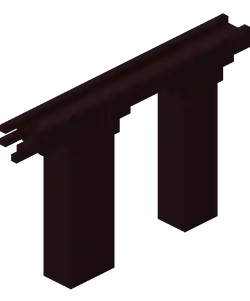
| Biomes |
Any Nether biome |
|---|---|
| Mobs | |
| Consists of |
|
{
"title": "Nether Fortress",
"rows": [
{
"field": "Any (link to Nether article, displayed as Nether) biome",
"label": "(link to Biome article, displayed as Biomes)"
},
{
"field": "(values exceeds 1000 characters...)",
"label": "(link to Mob article, displayed as Mobs)"
},
{
"field": "\n*See (link to #Structure article, displayed as <span style=\"white-space: nowrap;\">§ Structure</span>)\n*See (link to #Blocks article, displayed as <span style=\"white-space: nowrap;\">§ Blocks</span>)",
"label": "Consists of"
}
],
"invimages": [],
"images": [
"Nether Fortress.png"
]
}
A Nether fortress is a large structure found in the Nether, consisting of bridges, corridors, and towers. Nether fortresses are the only place where wither skeletons and blazes spawn. They also contain Nether wart.
Generation
Nether fortresses generate in all Nether biomes. To do so, the game splits the Nether into regions in which one of either a fortress or a bastion remnant can generate. The regions are 432×432 blocks in Java Edition and 480×480 blocks in Bedrock Edition.
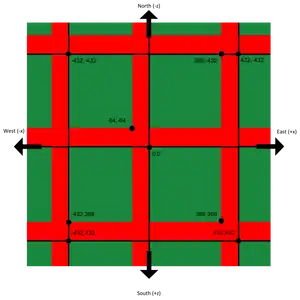
Each region has a four chunk separation located on the south and east borders of the region in which neither a fortress nor a bastion can generate.
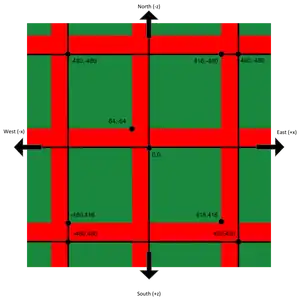
This leaves only a 368×368 block section in Java Edition or 416×416 block section in Bedrock Edition where a structure can generate.
Two structures never generate in the same region, although they might overlap if they generate close to the separation border. The chance of a fortress attempting to generate instead of a bastion is 2⁄5 (40%) in Java Edition and 1⁄3 (33.3%) in Bedrock Edition. However, if a bastion attempts to generate in the basalt deltas, a fortress generates instead, resulting in fortresses being the most common in the basalt deltas.
Nether fortresses can generate buried in netherrack. In such a case, the interior is not filled with netherrack; all hallways and passages are clear except for open walkways and bridges. It is possible but rare for glowstone or crimson and warped huge fungi to generate inside the fortress pathways.
Structure
Nether fortresses are large complexes composed of Nether bricks supported by pillars that tower high above the lava seas.
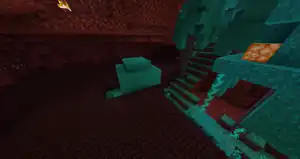
The fortress generation starts with a plain four-way crossing centered at chunk coordinates 11, ~, 11 of the designated chunk.
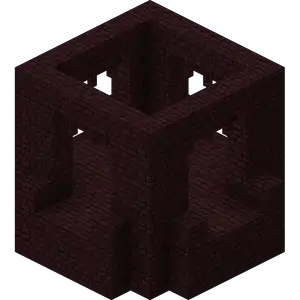
A fortress has two areas, an exterior area of open bridges and an interior area of enclosed corridors. Both the bridges and corridors can end in an unfinished passageway structure or may simply end without elaboration. Fortresses can tunnel through netherrack, giving the "exterior" areas an appearance of tunnels with Nether brick floor and netherrack walls and ceilings. At broken sections the terrain is not cleared, which may create a tunnel that leads straight into a wall of netherrack.
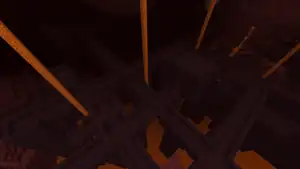
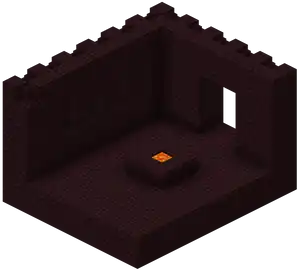
The exterior consists of:
- Straight bridges.
- Up to five plain four-way crossings.
- Up to four four-way crossings with arches made of Nether brick and Nether brick fences.
- Up to four small rooms with a single entrance and full-block "stairs" leading to the roof, which may have a single path leading out.
- Up to 2 blaze monster spawner platforms: structures consisting of three full-block "stairs" leading to a small platform fenced with Nether brick fence, with a blaze monster spawner in the center.
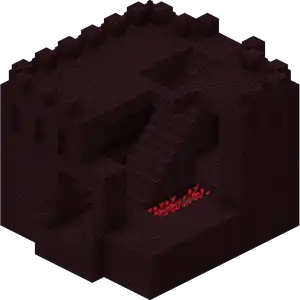
The interior of the structures have 1×2 windows with Nether brick fences as the windowpanes. The fences also form gate-like structures at the entrances of some rooms and corridors. Rooms include:
- The lava well room, which is the connection between the interior and exterior areas.
- Straight corridors.
- Up to five four-way crossings.
- Up to 20 corridor turns (10 right-turns and 10 left-turns), each with a 1⁄3 chance of having a loot chest in the corner.
- Up to three stairways made from actual stair blocks, leading downward.
- Up to two three-way intersections with a small exterior balcony.
- Up to two stairways leading up to a garden of soul sand and Nether wart at the base of the stairs, a corridor leading away from the upper landing and a corridor behind the stairs. If the room is generated embedded in netherrack, only one block above the landing is cleared.
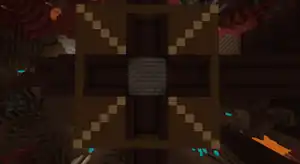
Blocks
| Block |
|---|
Bounding boxes
The structure bounding box for the 4-way intersection is pictured above (top-down view), and consists of a 19×11×19 volume centered on the floor block in the center of the intersection. This contrasts many of the other structure bounding boxes as their outlines tend to tightly follow the physical bounds of the structure. Notably, this also means that the fortress supports, which generate outside of that volume and go down to the ground and often into the lava ocean, are not considered part of the fortress for spawning purposes.
The area bounding box is a rectangular box that covers the entire fortress (again, excluding the supports). This is simply the smallest rectangular bounding box that can hold the bounding boxes of all structure pieces in the fortress.
Mobs
Fortresses use a list of possible mobs to spawn that is separate from the rest of the Nether, regardless of the biome the fortress generates in. This includes zombified piglins, skeletons, and magma cubes, as well as two exclusive mobs not found anywhere else: blazes and wither skeletons.
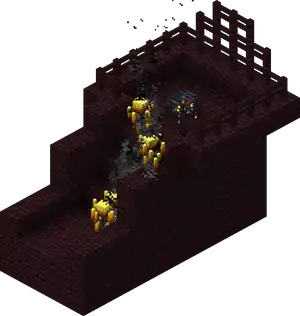
Mobs spawn at a much higher rate if the fortress is surrounded by soul sand valley or warped forest biomes, as hostile mobs in these biomes spawn much less frequently, allowing more hostile mobs to spawn in the fortress[1].
Java Edition
In Java Edition, the spawning algorithm has two checks:
- It checks if the spawn coordinates are within the "bounding box" of a single piece (e.g. corridor or walkway) of the fortress. (referred as "structure bounding box" above) In this case the block type of the ground does not matter.
- It checks if the spawn coordinates are within the "bounding box" (referred as "area bounding box" above) of the entire fortress and whether the ground consists of Nether bricks (not Nether brick slabs).
If either check passes, it uses the special mob list for fortresses rather than the list for the biome when choosing the mob to spawn. The actual mob spawning proceeds as normal for the mob chosen from this list.
| Mob | Spawn weight | Group size |
|---|---|---|
| Monster category | ||
| 10⁄28 | 2–3 | |
| 8⁄28 | 5 | |
| 5⁄28 | 4 | |
| 3⁄28 | 4 | |
| 2⁄28 | 5 | |
{ "notes": [], "1": { "totalWeight": 28, "mobs": [ { "size": "2-3", "mob": "Blaze", "weight": 10 }, { "size": "5", "mob": "Wither Skeleton", "weight": 8 }, { "size": "4", "mob": "Zombified Piglin", "weight": 5 }, { "size": "4", "mob": "Magma Cube", "weight": 3 }, { "size": "5", "mob": "Skeleton", "weight": 2 } ], "category": "monster" } }
Bedrock Edition
In Bedrock Edition, instead of spawning anywhere within a structural bounding box, most mobs spawn only in structure spawn locations along varied-length lines spaced apart 4-11 blocks throughout the fortress. They are not set to a particular Y level other than "inside the structure" and are indeed columns several blocks high. They do not require any special type of block, any regular spawnable block suffices.
To identify these spawning columns, glass panes can be placed all over the fortress, 1 block above surface blocks. This keeps the mobs stationary. (This technique works in Bedrock because structure spawns occur in the northwest corner of blocks.) Note that these spots may be on top of the raised side blocks, so these side blocks have to be removed before a glass pane grid can be placed.
| Mob | Spawn weight | Group size |
|---|---|---|
| Monster category | ||
| 10⁄28 | 1–2 | |
| 8⁄28 | 2–3 | |
| 5⁄28 | 1 | |
| 3⁄28 | 2–3 | |
| 2⁄28 | 2–3 | |
{ "notes": [], "1": { "totalWeight": 28, "mobs": [ { "size": "1-2", "mob": "Blaze", "weight": 10 }, { "size": "2-3", "mob": "Wither Skeleton", "weight": 8 }, { "size": "1", "mob": "Zombified Piglin", "weight": 5 }, { "size": "2-3", "mob": "Magma Cube", "weight": 3 }, { "size": "2-3", "mob": "Skeleton", "weight": 2 } ], "category": "monster" } }
Loot
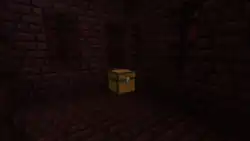
Fortresses generate Nether fortress loot with chests in the indoor sections placed at some corridor turns.
In Java Edition and Bedrock Edition, each nether fortress chest contains items drawn from 2 pools, with the following distribution:
| Item | Stack Size [A] | Weight [B] | Chance [C] | Avg. per chest [D] |
Avg. # chests to search [E] |
||
|---|---|---|---|---|---|---|---|
| 2–4× | 1× | 2–4× | 1× | ||||
| — | 1 | — | 14⁄15 | 93.3% | 0.933 | 1.1 | |
| 1–3 | — | 15⁄73 | — | 49.0% | 1.233 | 2.0 | |
| 1 | — | 10⁄73 | — | 35.3% | 0.411 | 2.8 | |
| 1 | — | 8⁄73 | — | 29.1% | 0.329 | 3.4 | |
| 3–7 | — | 5⁄73 | — | 19.0% | 1.027 | 5.3 | |
| 1–5 | — | 5⁄73 | — | 19.0% | 0.616 | 5.3 | |
| 1–3 | — | 5⁄73 | — | 19.0% | 0.411 | 5.3 | |
| 1 | — | 5⁄73 | — | 19.0% | 0.205 | 5.3 | |
| 1 | — | 5⁄73 | — | 19.0% | 0.205 | 5.3 | |
| 1 | — | 5⁄73 | — | 19.0% | 0.205 | 5.3 | |
| 1 | — | 5⁄73 | — | 19.0% | 0.205 | 5.3 | |
| 1 | — | 3⁄73 | — | 11.8% | 0.123 | 8.5 | |
| 2–4 | — | 2⁄73 | — | 8.0% | 0.247 | 12.5 | |
| — | 1 | — | 1⁄15 | 6.7% | 0.067 | 15.0 | |
{ "chestNames": [ "nether-fortress" ], "gameVersion": "Java", "loot": { "nether-fortress": { "poolsJava": [ { "items": { "diamond": [ 1, 3, 5 ], "saddle": [ 1, 1, 10 ], "obsidian": [ 2, 4, 2 ], "gold-ingot": [ 1, 3, 15 ], "diamond-horse-armor": [ 1, 1, 3 ], "golden-chestplate": [ 1, 1, 5 ], "iron-horse-armor": [ 1, 1, 5 ], "golden-horse-armor": [ 1, 1, 8 ], "golden-sword": [ 1, 1, 5 ], "iron-ingot": [ 1, 5, 5 ], "flint-and-steel": [ 1, 1, 5 ], "nether-wart": [ 3, 7, 5 ] }, "rolls": [ 2, 4 ], "totalweight": 73 }, { "items": { "empty": [ 1, 1, 14 ], "rib-armor-trim-smithing-template": [ 1, 1, 1 ] }, "rolls": [ 1, 1 ], "totalweight": 15 } ], "poolsBedrockUpcoming": [], "itemDataJava": { "diamond": { "itemname": "diamond", "sizes": [ "1–3", "—" ], "sortsize": [ 2, 0 ], "sortweight": [ 5, 0 ], "weights": [ "<sup>5</sup>⁄<sub>73</sub>", "—" ], "avgamount": 0.410958904109589, "chanceany": 0.1903699481480795 }, "diamond-horse-armor": { "itemname": "diamond-horse-armor", "sizes": [ 1, "—" ], "sortsize": [ 1, 0 ], "sortweight": [ 3, 0 ], "weights": [ "<sup>3</sup>⁄<sub>73</sub>", "—" ], "avgamount": 0.1232876712328767, "chanceany": 0.1177728226195418 }, "rib-armor-trim-smithing-template": { "itemname": "rib-armor-trim-smithing-template", "sizes": [ "—", 1 ], "sortsize": [ 0, 1 ], "sortweight": [ 0, 1 ], "weights": [ "—", "<sup>1</sup>⁄<sub>15</sub>" ], "avgamount": 0.06666666666666667, "chanceany": 0.06666666666666665 }, "obsidian": { "itemname": "obsidian", "sizes": [ "2–4", "—" ], "sortsize": [ 3, 0 ], "sortweight": [ 2, 0 ], "weights": [ "<sup>2</sup>⁄<sub>73</sub>", "—" ], "avgamount": 0.2465753424657534, "chanceany": 0.07972383453843734 }, "gold-ingot": { "itemname": "gold-ingot", "sizes": [ "1–3", "—" ], "sortsize": [ 2, 0 ], "sortweight": [ 15, 0 ], "weights": [ "<sup>15</sup>⁄<sub>73</sub>", "—" ], "avgamount": 1.2328767123287672, "chanceany": 0.48956430083116764 }, "empty": { "itemname": "empty", "sizes": [ "—", 1 ], "sortsize": [ 0, 1 ], "sortweight": [ 0, 14 ], "weights": [ "—", "<sup>14</sup>⁄<sub>15</sub>" ], "avgamount": 0.9333333333333333, "chanceany": 0.9333333333333333 }, "saddle": { "sortsize": [ 1, 0 ], "weights": [ "<sup>10</sup>⁄<sub>73</sub>", "—" ], "chanceany": 0.35257500631817307, "sizes": [ 1, "—" ], "sortweight": [ 10, 0 ], "armor": 0, "material": 0, "avgamount": 0.410958904109589, "itemname": "saddle" }, "golden-chestplate": { "sortsize": [ 1, 0 ], "weights": [ "<sup>5</sup>⁄<sub>73</sub>", "—" ], "chanceany": 0.1903699481480795, "sizes": [ 1, "—" ], "sortweight": [ 5, 0 ], "armor": 2, "material": 3, "avgamount": 0.2054794520547945, "itemname": "golden-chestplate" }, "iron-horse-armor": { "sortsize": [ 1, 0 ], "weights": [ "<sup>5</sup>⁄<sub>73</sub>", "—" ], "chanceany": 0.1903699481480795, "sizes": [ 1, "—" ], "sortweight": [ 5, 0 ], "armor": 0, "material": 2, "avgamount": 0.2054794520547945, "itemname": "iron-horse-armor" }, "iron-ingot": { "itemname": "iron-ingot", "sizes": [ "1–5", "—" ], "sortsize": [ 3, 0 ], "sortweight": [ 5, 0 ], "weights": [ "<sup>5</sup>⁄<sub>73</sub>", "—" ], "avgamount": 0.6164383561643836, "chanceany": 0.1903699481480795 }, "golden-sword": { "sortsize": [ 1, 0 ], "weights": [ "<sup>5</sup>⁄<sub>73</sub>", "—" ], "chanceany": 0.1903699481480795, "sizes": [ 1, "—" ], "sortweight": [ 5, 0 ], "armor": 0, "material": 3, "avgamount": 0.2054794520547945, "itemname": "golden-sword" }, "golden-horse-armor": { "itemname": "golden-horse-armor", "sizes": [ 1, "—" ], "sortsize": [ 1, 0 ], "sortweight": [ 8, 0 ], "weights": [ "<sup>8</sup>⁄<sub>73</sub>", "—" ], "avgamount": 0.3287671232876712, "chanceany": 0.2908800818567131 }, "flint-and-steel": { "sortsize": [ 1, 0 ], "weights": [ "<sup>5</sup>⁄<sub>73</sub>", "—" ], "chanceany": 0.1903699481480795, "sizes": [ 1, "—" ], "sortweight": [ 5, 0 ], "armor": 0, "material": 0, "avgamount": 0.2054794520547945, "itemname": "flint-and-steel" }, "nether-wart": { "itemname": "nether-wart", "sizes": [ "3–7", "—" ], "sortsize": [ 5, 0 ], "sortweight": [ 5, 0 ], "weights": [ "<sup>5</sup>⁄<sub>73</sub>", "—" ], "avgamount": 1.0273972602739727, "chanceany": 0.1903699481480795 } }, "display_name": "nether fortress", "structID": "nether-fortress", "poolsJavaUpcoming": [], "structure": "Nether Fortress", "container": "", "itemDataJavaUpcoming": [], "allRollsJavaUpcoming": [], "itemDataBedrock": { "diamond": { "itemname": "diamond", "sizes": [ "1–3", "—" ], "sortsize": [ 2, 0 ], "sortweight": [ 5, 0 ], "weights": [ "<sup>5</sup>⁄<sub>73</sub>", "—" ], "avgamount": 0.410958904109589, "chanceany": 0.1903699481480795 }, "diamond-horse-armor": { "itemname": "diamond-horse-armor", "sizes": [ 1, "—" ], "sortsize": [ 1, 0 ], "sortweight": [ 3, 0 ], "weights": [ "<sup>3</sup>⁄<sub>73</sub>", "—" ], "avgamount": 0.1232876712328767, "chanceany": 0.1177728226195418 }, "rib-armor-trim-smithing-template": { "itemname": "rib-armor-trim-smithing-template", "sizes": [ "—", 1 ], "sortsize": [ 0, 1 ], "sortweight": [ 0, 1 ], "weights": [ "—", "<sup>1</sup>⁄<sub>15</sub>" ], "avgamount": 0.06666666666666667, "chanceany": 0.06666666666666665 }, "obsidian": { "itemname": "obsidian", "sizes": [ "2–4", "—" ], "sortsize": [ 3, 0 ], "sortweight": [ 2, 0 ], "weights": [ "<sup>2</sup>⁄<sub>73</sub>", "—" ], "avgamount": 0.2465753424657534, "chanceany": 0.07972383453843734 }, "gold-ingot": { "itemname": "gold-ingot", "sizes": [ "1–3", "—" ], "sortsize": [ 2, 0 ], "sortweight": [ 15, 0 ], "weights": [ "<sup>15</sup>⁄<sub>73</sub>", "—" ], "avgamount": 1.2328767123287672, "chanceany": 0.48956430083116764 }, "empty": { "itemname": "empty", "sizes": [ "—", 1 ], "sortsize": [ 0, 1 ], "sortweight": [ 0, 14 ], "weights": [ "—", "<sup>14</sup>⁄<sub>15</sub>" ], "avgamount": 0.9333333333333333, "chanceany": 0.9333333333333333 }, "saddle": { "sortsize": [ 1, 0 ], "weights": [ "<sup>10</sup>⁄<sub>73</sub>", "—" ], "chanceany": 0.35257500631817307, "sizes": [ 1, "—" ], "sortweight": [ 10, 0 ], "armor": 0, "material": 0, "avgamount": 0.410958904109589, "itemname": "saddle" }, "golden-chestplate": { "sortsize": [ 1, 0 ], "weights": [ "<sup>5</sup>⁄<sub>73</sub>", "—" ], "chanceany": 0.1903699481480795, "sizes": [ 1, "—" ], "sortweight": [ 5, 0 ], "armor": 2, "material": 3, "avgamount": 0.2054794520547945, "itemname": "golden-chestplate" }, "iron-horse-armor": { "sortsize": [ 1, 0 ], "weights": [ "<sup>5</sup>⁄<sub>73</sub>", "—" ], "chanceany": 0.1903699481480795, "sizes": [ 1, "—" ], "sortweight": [ 5, 0 ], "armor": 0, "material": 2, "avgamount": 0.2054794520547945, "itemname": "iron-horse-armor" }, "iron-ingot": { "itemname": "iron-ingot", "sizes": [ "1–5", "—" ], "sortsize": [ 3, 0 ], "sortweight": [ 5, 0 ], "weights": [ "<sup>5</sup>⁄<sub>73</sub>", "—" ], "avgamount": 0.6164383561643836, "chanceany": 0.1903699481480795 }, "golden-sword": { "sortsize": [ 1, 0 ], "weights": [ "<sup>5</sup>⁄<sub>73</sub>", "—" ], "chanceany": 0.1903699481480795, "sizes": [ 1, "—" ], "sortweight": [ 5, 0 ], "armor": 0, "material": 3, "avgamount": 0.2054794520547945, "itemname": "golden-sword" }, "golden-horse-armor": { "itemname": "golden-horse-armor", "sizes": [ 1, "—" ], "sortsize": [ 1, 0 ], "sortweight": [ 8, 0 ], "weights": [ "<sup>8</sup>⁄<sub>73</sub>", "—" ], "avgamount": 0.3287671232876712, "chanceany": 0.2908800818567131 }, "flint-and-steel": { "sortsize": [ 1, 0 ], "weights": [ "<sup>5</sup>⁄<sub>73</sub>", "—" ], "chanceany": 0.1903699481480795, "sizes": [ 1, "—" ], "sortweight": [ 5, 0 ], "armor": 0, "material": 0, "avgamount": 0.2054794520547945, "itemname": "flint-and-steel" }, "nether-wart": { "itemname": "nether-wart", "sizes": [ "3–7", "—" ], "sortsize": [ 5, 0 ], "sortweight": [ 5, 0 ], "weights": [ "<sup>5</sup>⁄<sub>73</sub>", "—" ], "avgamount": 1.0273972602739727, "chanceany": 0.1903699481480795 } }, "poolsBedrock": [ { "items": { "diamond": [ 1, 3, 5 ], "saddle": [ 1, 1, 10 ], "obsidian": [ 2, 4, 2 ], "gold-ingot": [ 1, 3, 15 ], "diamond-horse-armor": [ 1, 1, 3 ], "golden-chestplate": [ 1, 1, 5 ], "iron-horse-armor": [ 1, 1, 5 ], "golden-horse-armor": [ 1, 1, 8 ], "golden-sword": [ 1, 1, 5 ], "iron-ingot": [ 1, 5, 5 ], "flint-and-steel": [ 1, 1, 5 ], "nether-wart": [ 3, 7, 5 ] }, "rolls": [ 2, 4 ], "totalweight": 73 }, { "items": { "empty": [ 1, 1, 14 ], "rib-armor-trim-smithing-template": [ 1, 1, 1 ] }, "rolls": [ 1, 1 ], "totalweight": 15 } ], "allRollsBedrockUpcoming": [], "allRollsBedrock": [ "2–4", 1 ], "itemDataBedrockUpcoming": [], "header": "[[Nether Fortress]]", "allRollsJava": [ "2–4", 1 ], "link": "[[nether fortress]]" } } }- ↑ The size of stacks (or for unstackable items, number) of this item on any given roll.
- ↑ The weight of this item relative to other items in the pool.
- ↑ The odds of finding any of this item in a single chest.
- ↑ The number of items expected per chest, averaged over a large number of chests.
- ↑ The average number of chests the player should expect to search to find any of this item.
- ↑ 'Nothing' does not refer to the chance of an empty chest. Instead, it refers to the chance that the random loot generator does not add any loot on a single roll.
Data values
ID
| Structure type | Identifier |
|---|---|
fortress |
| Structure | Identifier |
|---|---|
fortress |
| Structure | Identifier | Translation key |
|---|---|---|
fortress | feature |
Config
- [NBT Compound / JSON Object] Structure configuration
- [String] type:
minecraft:fortress - Fields common to all structures see Template:Nbt inherit/structure/template
- [String] type:
Advancements
| Icon | Advancement | In-game description | Actual requirements (if different) |
|---|---|---|---|
 | A Terrible Fortress | Break your way into a Nether Fortress | Enter a nether fortress. |
Video
History
| Java Edition | |||||||
|---|---|---|---|---|---|---|---|
| 1.0.0 | September 16, 2011 | Jeb tweets a teaser screenshot of changes to the Nether terrain generation, including fortresses. | |||||
| September 19, 2011 | Jeb releases a second teaser screenshot, showcasing the structure of the then upcoming fortresses. | ||||||
| September 21, 2011 | Jeb mentions that he is finished with most of the new Nether features, including two new mobs, one of which is a "retexturing attempt". | ||||||
| Beta 1.9 Prerelease | Added Nether fortresses. | ||||||
| 1.4.2 | 12w36a | Wither skeletons and skeletons now naturally spawn in fortresses. | |||||
| As a result, other mobs also found in fortresses spawn less often. Zombie pigmen's spawning weight is halved, making them significantly less common. | |||||||
| 1.6.1 | 13w18a | Chests now generate in fortresses. | |||||
| 1.8 | 14w27a | Fortresses are now affected by the "Generated structures" option. | |||||
| 14w30a | Added possibility of obsidian in chests. | ||||||
| 1.9 | 15w43a | Reduced loot in chests from 2–5 stacks to 2–4 stacks. | |||||
| 1.16 | 20w06a | Fortresses can now spawn in the soul sand valley biome. | |||||
| 20w15a | Fortresses can now spawn in the basalt deltas biome. | ||||||
| 20w16a | Fortresses now generate evenly throughout the Nether. | ||||||
| Pre-release 3 | Fortresses are now slightly more common. | ||||||
| 1.18 | ? | If a bastion remnant attempts to generate in a basalt delta, a fortress generates in its place, instead of being skipped entirely. | |||||
| 1.19.4 Experiment | 23w04a | Rib armor trim is now found in fortress chests. | |||||
| 23w05a | Increased the chance that rib armor trim is found in fortress chests from 4.7% to 6.7%. | ||||||
| Pocket Edition Alpha | |||||||
| v0.12.1 | build 1 | Added fortresses. | |||||
| v0.15.0 | build 1 | Horse armor can now be found in chest loot. | |||||
| Bedrock Edition | |||||||
| 1.19.80 Experiment | Preview 1.19.80.21 | Rib armor trim is now found in fortress chests. | |||||
| Legacy Console Edition | |||||||
| Xbox 360 | Xbox One | PS3 | PS4 | PS Vita | Wii U | Switch | |
| TU7 | CU1 | 1.00 | 1.00 | 1.00 | Patch 1 | 1.0.1 | Added fortresses. |
| TU9 | Changed fortresses to make Nether wart rooms more likely. | ||||||
| TU19 | CU7 | 1.12 | 1.12 | 1.12 | Wither skeletons and skeletons now naturally spawn in fortresses. | ||
| As a result, other mobs also found in fortresses spawn less often. Zombie pigmen's spawning weight is halved, making them significantly less common. | |||||||
| Chests now generate. | |||||||
| TU31 | CU19 | 1.22 | 1.22 | 1.22 | Patch 3 | Added possibility of obsidian in chests. | |
| New Nintendo 3DS Edition | |||||||
| 0.1.0 | Added fortresses. | ||||||
-
 The first screenshot of Nether fortress.
The first screenshot of Nether fortress. -
 A brightened version of the previous screenshot.
A brightened version of the previous screenshot. -
 The second screenshot, showing a large complex of the Nether fortress.
The second screenshot, showing a large complex of the Nether fortress. -
 The second screenshot brightened.
The second screenshot brightened. -
 A Nether fortress in the overworld.
A Nether fortress in the overworld.
Issues
Issues relating to "Nether Fortress" are maintained on the bug tracker. Issues should be reported and viewed there.
Trivia
- In rare cases, a fortress may not generate any indoor rooms except one single lava room[2]. This usually occurs when a portion of the exterior section of the fortress blocks the exit to the interior section of the lava well room.
- Sometimes, two or more fortresses can generate close to or even within one another, creating an even larger cumulative fortress.
- There is an opening out of the fortress under the lava well, with a single block of Nether bricks from which the lava spreads out.
- The soul sand valley bone blocks and basalt pillars (down to within three blocks as-usual of a walkway) can replace more Nether bricks. Less-often, huge fungi, Nether wart blocks, warped wart blocks, crimson stems, and warped stems can replace Nether brick, most visibly along walls.
- A fortress can be seen in the background in the Nether in A Minecraft Movie.[3]
Gallery
Screenshots
-
 Some Nether warts found at a stair.
Some Nether warts found at a stair. -
 A demonstration of the pathway architecture and its ability to cut through netherrack.
A demonstration of the pathway architecture and its ability to cut through netherrack. -
 The blaze monster spawner room.
The blaze monster spawner room. -
 The abrupt end of an inside corridor.
The abrupt end of an inside corridor. -
 The broken passways.
The broken passways. -
 A large amount of corridors. Notice how corridors do not develop arches in their supports.
A large amount of corridors. Notice how corridors do not develop arches in their supports. -
 A ghast that has spawned inside of one of the larger rooms.
A ghast that has spawned inside of one of the larger rooms. -
 A player in a fortress with another Nether fortress across from it.
A player in a fortress with another Nether fortress across from it. -
 A fortress with another one generated on top of it.
A fortress with another one generated on top of it. -
 The lava well room.
The lava well room. -
 A fortress in a warped forest biome.
A fortress in a warped forest biome. -
 A fortress in a crimson forest biome.
A fortress in a crimson forest biome. -
 A fortress in a basalt deltas biome.
A fortress in a basalt deltas biome. -
 A large Nether fortress.
A large Nether fortress. -
 A blaze on fire, preparing to attack.
A blaze on fire, preparing to attack. -
 A flying blaze ready to attack.
A flying blaze ready to attack. -
 A blaze and a wither skeleton in a fortress.
A blaze and a wither skeleton in a fortress. -

-
 A blaze monster spawner room surrounded by netherrack.
A blaze monster spawner room surrounded by netherrack. -

In other media
-
 A nether fortress as it appears in Minecraft Dungeons
A nether fortress as it appears in Minecraft Dungeons -
 A nether fortress as it appears in Sonic Racing: CrossWorlds.
A nether fortress as it appears in Sonic Racing: CrossWorlds.
References
- ↑ MC-182170
- ↑ MC-194769 — Nether Fortresses can generate without a lava room and corridor section.
- ↑ "We didn’t really go into the Nether Fortress , you just see it in the background: there were some designs made way back but not in the same style as the mobs , probably won’t share that! I agree! They’re awesome once you figure out how not to get hit with their fireballs" – @torfi_F_Olafss on X (formerly Twitter), April 6, 2025
| |||||||||||||||||||||||||||
| |||||||||||||||||||||||||||